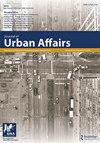外地人与本地搬家公司的社区和住房选择:北卡罗来纳州夏洛特市的案例
IF 1.9
3区 经济学
Q2 URBAN STUDIES
引用次数: 0
摘要
摘要本文以北卡罗来纳州夏洛特市为例,比较了外地人和本地人对住房和社区的选择。外来迁入者的定义是那些从200英里以外的地方迁入的人,他们促使我们分析外部人口压力是否在整个城市均匀分布。我们利用独特的数据源组合,包括来自基于网络的仪表板的社区“生活质量”指标和来自Multiple Listing Service的房产广告文本。我们的研究结果突出了外地人比例较高的家庭和社区的鲜明特征:优秀的公立学校,拥有高档厨房的独户住宅,以及健身设施。社区里有很多受过高等教育的白人居民。相比之下,那些更适合步行、更适合骑自行车、或靠近公共交通、需要翻修房屋的社区,往往会吸引更少的外地人。这一分析揭示了在大流行期间,一个快速发展的城市的高机会社区所经历的不平等需求。关键词:居住区位选择;社区设施;房地产披露声明作者未报告潜在的利益冲突。注意,在我们的分析中,比率变量是根据移动到每个社区的距离来计算的,显示夏洛特中心的地图仅供参考。elizabeth C. Delmelle elizabeth C. Delmelle是宾夕法尼亚大学城市和区域规划系的副教授,也是城市空间分析硕士(MUSA)项目的主任。她的研究集中在社区变化、城市不平等和城市交通的过程。她喜欢寻找新的数据来源和空间分析方法,以更好地理解社区如何、为什么以及何时在多个维度上发生变化。Isabelle Nilsson是北卡罗来纳大学夏洛特分校地理与地球科学系副教授,也是公共政策博士项目的教员。她的研究兴趣集中在住房和交通方面。她特别感兴趣的是公共和私人投资对家庭选址行为的影响,以及这些微观层面的行为如何塑造城市内部的分类模式。普罗维登斯·阿杜(Providence Adu)是北卡罗来纳大学夏洛特分校地理学博士候选人。他是夏洛特市的前规划师。他拥有克莱姆森大学城市与区域规划硕士学位。他的研究兴趣和工作包括住房政策,社区变化,隔离,以及GIScience和机器学习方法在社会科学研究中的应用。他是北卡罗来纳大学夏洛特城市研究所的研究助理。本文章由计算机程序翻译,如有差异,请以英文原文为准。
Neighborhood and housing choices of out-of-town versus local movers: The case of Charlotte, North Carolina
ABSTRACTUsing Charlotte, North Carolina as a case study, we compare the housing and neighborhood choices of out-of-town movers compared to locals. Out-of-town movers, defined as those relocating from more than 200 miles, prompt our analysis of whether external population pressures were distributed evenly throughout the city. We leverage a unique combination of data sources, including neighborhood ”quality of life” indicators from a web-based dashboard and property advertisement text from the Multiple Listing Service. Our findings highlight distinct characteristics of homes and neighborhoods with a higher proportion of out-of-town movers: excellent public schools, single-family homes with upscale kitchens, and fitness amenities. Neighborhoods have a population of highly educated, White residents. In contrast, neighborhoods that are more pedestrian-friendly, bicycle-accessible, or close to public transit and require property renovations tend to attract fewer out-of-town movers. This analysis reveals the unequal demand experienced by high-opportunity neighborhoods in a fast-growing city during the pandemic.KEYWORDS: Residential location choiceneighborhood amenitiesreal estate Disclosure statementNo potential conflict of interest was reported by the author(s).Notes1. Note, in our analysis, the ratio variable is calculated as the distance moved into each neighborhood, the map showing the center of Charlotte is simply for reference purposes.Additional informationNotes on contributorsElizabeth C. DelmelleElizabeth C. Delmelle is an associate professor in the City and Regional Planning Department at the University of Pennsylvania and director of the Master of Urban Spatial Analytics (MUSA) program. Her research centers on processes of neighborhood change, urban inequality, and urban transportation. She enjoys seeking out new data sources and spatial analytical methods to better understand how, why, and when neighborhoods change across multiple dimensions.Isabelle NilssonIsabelle Nilsson is an associate professor in the Department of Geography and Earth Sciences and a faculty member in the Public Policy PhD program at the University of North Carolina at Charlotte. Her research interests are focused on housing and transportation. She is especially interested in the effects of public and private investments on household location behavior and how these micro-level behaviors shape intra-urban sorting patterns.Providence AduProvidence Adu is a PhD candidate in geography at the University of North Carolina at Charlotte. He is a former planner for the city of Charlotte. He holds an MS in City and Regional Planning from Clemson University. His research interests and work include housing policy, neighborhood change, segregation, and the application of GIScience and machine learning methods to social science research. He works as a research assistant for the UNC Charlotte Urban Institute.
求助全文
通过发布文献求助,成功后即可免费获取论文全文。
去求助
来源期刊

Journal of Urban Affairs
URBAN STUDIES-
CiteScore
5.40
自引率
4.80%
发文量
156
期刊介绍:
Focusing on urban research and policy analysis, the Journal of Urban Affairs is among the most widely cited journals in the field. Published for the Urban Affairs Association, the journal offers multidisciplinary perspectives and explores issues of relevance to both scholars and practitioners, including: - Theoretical, conceptual, or methodological approaches to metropolitan and community problems - Empirical research that advances the understanding of society - Strategies for social change in the urban milieu - Innovative urban policies and programs - Issues of current interest to those who work in the field and those who study the urban and regional environment
 求助内容:
求助内容: 应助结果提醒方式:
应助结果提醒方式:


